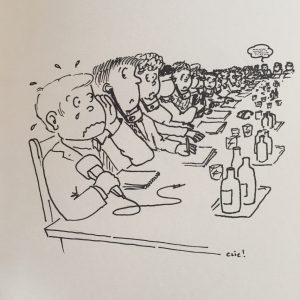
The following is an extract from the chapter “Protocol & Practicalities” in Consecutive Interpreting by Andrew Gillies, Routledge, 2019 (p214-223), and outlines a few practical points to be aware of when you go work on site with customers.
Dress code
| An interpreter can be forgiven anything, except being late and not being dressed appropriately. Ouvrard 2014:111 |
Dressing appropriately is a mark of respect to your customer (and colleagues) so if you want to be recruited again do make an effort. A good rule of thumb would be to try to pitch your dress somewhere in the middle of the style that is being worn by your clients and not at the extremes. Be aware also that your clients may well be considerably older than you, something that may affect what is considered appropriate dress.
…
What to do when you arrive on site
The following is a general guide. Be aware however that there may already be established institutional or corporate protocol covering your assignment. Find out what those rules are as they will take precedence over these suggestions.
- arrive before your customer (s) if you are not travelling with them already.
- if you are the only interpreter introduce yourself to the head of protocol and/or the speaker(s) at the appropriate time, if any. If you are part of a team of interpreters ask the head of team.
1) if it is appropriate to introduce yourself to the speaker(s). It may not be in a big team of interpreters. And…
2) to introduce you to your speaker(s) or give you permission to introduce yourself.
This way they won’t be surprised when you start interpreting; and you will have the chance to establish and/or briefly explain the mode of interpreting (here consecutive) and length of passage to be spoken/interpreted. Both passages that are too short (sentence by sentence), and too long (10 minutes and more), can cause problems for an audience even if the interpreter is happy with either.
| When dealing with meeting organisers or speakers be polite and remember that the interpreting is only the most important thing going on to you. Everyone else will have other priorities. So don’t get upset or uppity if what you need is not at the top of people’s priorities. |
- if it is not already defined by protocol rules establish with your colleagues who is going to interpret which speakers and/or which half hours. If there are protocol rules then find out what they are! (On most diplomatic business each government brings their own interpreters who interpret what their own side says.)
- do ask your senior colleagues (and to start with everyone will be senior to you!) for any information they can give you about the speaker, the venue, the event, procedural and protocol rules or the way the assignment will go.
- ask for a list of names of speakers and significant people present. If you can’t have a guess at who might be there: the mayor of the city you’re in; the Head of the host institution etc. (See also Advanced Preparation p???)
- ask for a fixed microphone in a stand. Holding the microphone and the notepad while speaking, and turning pages all at the same time is tricky and inevitably leads to paper rustling noises being heard over the microphone.
- if you have been given a hand-held microphone make sure it’s off an safely in a pocket or placed somewhere while you listen and turned on and in your hand when you speak.
- ask for speaking notes, the text of speeches and any other documents that may have been made available since documents were last sent to the interpreters, including speeches you may not be interpreting – there may be useful information there too.
- position yourself where you can see and hear the speaker and where you can easily present your interpretation to the same audience as the speaker. In practice that means close by! Ideally you shouldn’t have to move at all or more than a few paces in order to start your interpreting. You won’t be able to face the speaker, because both you and they will be facing the audience, but if you’re standing just in front or behind and to one side of the speaker you will be able to see their face as they speak. At an assignment where you are sitting you are most likely to be alongside the speaker or at right-angles to them, without much flexibility to adjust. Don’t find yourself on the other side of the room!

- drink enough water to keep your mouth from drying up but not so much you need to go to the toilet all the time! If you do need to excuse yourself make sure you let someone know you’ve popped away. That way you can avoid clients fretting about an absent interpreter or leaving the building without you.
- look at your surroundings. Make a mental note of any particularly prominent works of art or architectural features and what they represent. If there are information plaques around the building, and if your assignment allows, read them! It’s exactly the sort of information that might get thrown into a speech. Likewise if you get the chance ask the venue’s staff for pointers about significant facts, people and events relating to the venue.
- turn your phone off!
For the complete list and further tips about protocol and practicaliies check out Consecutive Interpreting by Andrew Gillies, Routledge, 2019 p214-223
With thanks to Clic! for this fantastic illustration.